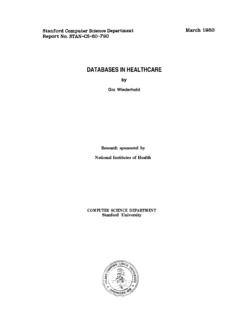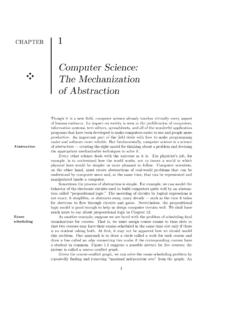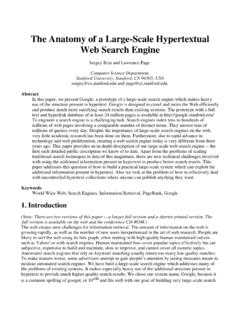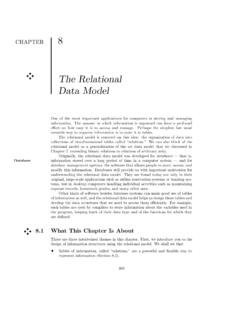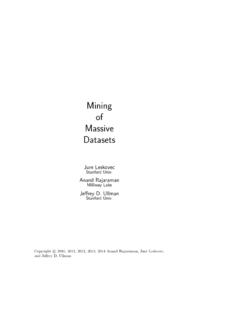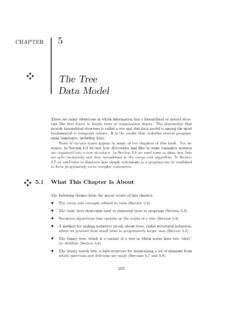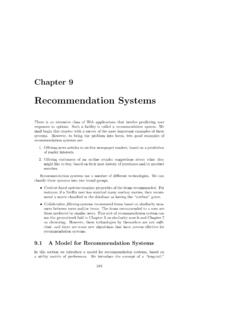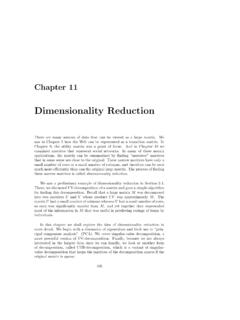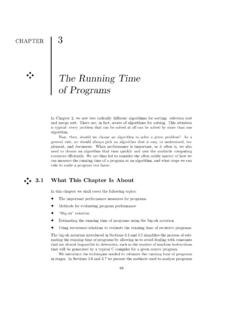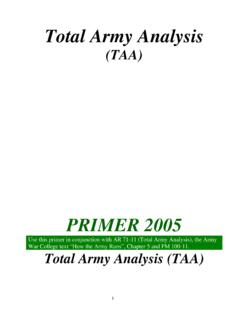Transcription of preface - The Stanford University InfoLab
1 preface This book was motivated by the desire we and others have had to further the evolu- tion of the core course in computer science. Many departments across the country have revised their curriculum in response to the introductory course in the science of computing discussed in the Denning Report, (Denning, P. J., D. E. Comer, D. Gries, M. C. Mulder, A. Tucker, J. Turner, and P. R. Young, Computing as a Dis- cipline, Comm. ACM 32:1, pp. 9 23, January 1989.). That report draws attention to three working methodologies or processes theory, abstraction, and design . as fundamental to all undergraduate programs in the discipline. More recently, the Computing Curricula 1991 report of the joint ACM/IEEE-CS Curriculum Task Force echoes the Denning Report in identifying key recurring concepts which are fundamental to computing, especially: conceptual and formal models, efficiency, and levels of abstraction.
2 The themes of these two reports summarize what we have tried to offer the student in this book. This book developed from notes for a two-quarter course at Stanford called CS109: Introduction to Computer Science that serves a number of goals. The first goal is to give beginning computer science majors a solid foundation for fur- ther study. However, computing is becoming increasingly important in a much wider range of scientific and engineering disciplines. Therefore, a second goal is to give those students who will not take advanced courses in computer science the conceptual tools that the field provides. Finally, a more pervasive goal is to expose all students not only to programming concepts but also to the intellectually rich foundations of the field. Our first version of this book was based on programming in Pascal and appeared in 1992. Our choice of Pascal as the language for example programs was motivated by that language's use in the Computer Science Advanced Placement Test as well as in a plurality of college introductions to programming.
3 We were pleased to see that since 1992 there has been a significant trend toward C as the introductory programming language, and we accordingly developed a new version of the book using C for programming examples. Our emphasis on abstraction and encapsulation should provide a good foundation for subsequent courses covering object-oriented technology using C++. At the same time, we decided to make two significant improvements in the content of the book. First, although it is useful to have a grounding in machine architecture to motivate how running time is measured, we found that almost all curricula separate architecture into a separate course, so the chapter on that subject was not useful. Second, many introductory courses in the theory of computing emphasize combinatorics and probability, so we decided to increase the coverage and cluster the material into a chapter of its own.
4 Foundations of Computer Science covers subjects that are often found split between a discrete mathematics course and a sophomore-level sequence in computer science in data structures. It has been our intention to select the mathematical foundations with an eye toward what the computer user really needs, rather than what a mathematician might choose. We have tried to integrate effectively the mathematical foundations with the computing. We thus hope to provide a better feel for the soul of computer science than might be found in a programming course, ix x preface . a discrete mathematics course, or a course in a computer science subspecialty. We believe that, as time goes on, all scientists and engineers will take a foundational course similar to the one offered at Stanford upon which this book is based. Such a course in computer science should become as standard as similar courses in calculus and physics.
5 Prerequisites Students taking courses based on this book have ranged from first-year undergrad- uates to graduate students. We assume only that students have had a solid course in programming. They should be familiar with the programming language ANSI. C to use this edition. In particular, we expect students to be comfortable with C. constructs such as recursive functions, structures, pointers, and operators involving pointers and structures such as dot, ->, and &. Suggested Outlines for Foundational Courses in CS. In terms of a traditional computer science curriculum, the book combines a first course in data structures that is, a CS2 course with a course in discrete mathematics. We believe that the integration of these subjects is extremely desir- able for two reasons: 1. It helps motivate the mathematics by relating it more closely to the computing. 2. Computing and mathematics can be mutually reinforcing.
6 Some examples are the way recursive programming and mathematical induction are related in Chapter 2 and the way the free/bound variable distinction for logic is related to the scope of variables in programming languages in Chapter 14. Suggestions for instructive programming assignments are presented throughout the book. There are a number of ways in which this book can be used. A Two-Quarter or Two-Semester Course The CS109A-B sequence at Stanford is typical of what might be done in two quar- ters, although these courses are rather intensive, being 4-unit, 10-week courses each. These two courses cover the entire book, the first seven chapters in CS109A and Chapters 8 through 14 in CS109B. A One-Semester CS2 Type Course It is possible to use the book for a one-semester course covering a set of topics similar to what would appear in a CS2 course. Naturally, there is too much material in the book to cover in one semester, and so we recommend the following: 1.
7 Recursive algorithms and programs in Sections and 2. Big-oh analysis and running time of programs: all of Chapter 3 except for Section on solving recurrence relations. 3. Trees in Sections through preface xi 4. Lists: all of Chapter 6. Some may wish to cover lists before trees, which is a more traditional treatment. We regard trees as the more fundamental notion, but there is little harm in switching the order. The only significant dependency is that Chapter 6 talks about the dictionary abstract data type (set with operations insert, delete, and lookup), which is introduced in Section as a concept in connection with binary search trees. 5. Sets and relations. Data structures for sets and relations are emphasized in Sections through and through 6. Graph algorithms are covered in Sections through A One-Semester Discrete Mathematics Course For a one-semester course emphasizing mathematical foundations, the instructor could choose to cover: 1.
8 Mathematical induction and recursive programs in Chapter 2. 2. Big-oh analysis, running time, and recurrence relations in Sections through 3. Combinatorics in Sections through 4. Discrete probability in Sections through 5. Mathematical aspects of trees in Sections through 6. Mathematical aspects of sets in Sections , , , , and 7. The algebra of relations in Sections , , and 8. Graph algorithms and graph theory in Chapter 9. 9. Automata and regular expressions in Chapter 10. 10. Context-free grammars in Sections through 11. Propositional and predicate logic in Chapters 12 and 14, respectively. Features of This Book To help the student assimilate the material, we have added the following study aids: 1. Each chapter has an outline section at the beginning and a summary section at the end highlighting the main points. 2. Marginal notes mark important concepts and definitions.
9 However, items men- tioned in section or subsection headlines are not repeated in the margin. 3. Sidebars are separated from the text by double lines. These short notes serve several purposes: Some are elaborations on the text or make some fine points about program or algorithm design. Others are for summary or emphasis of points made in the text nearby. These include outlines of important kinds of proofs, such as the various forms of proof by induction. A few are used to give examples of fallacious arguments, and we hope that the separation from the text in this way will eliminate possible miscon- struction of the point. xii preface . A few give very brief introductions to major topics like undecidability or the history of computers to which we wish we could devote a full section. 4. Most of the sections end with exercises. There are more than 1000 exercises or parts spread among the sections.
10 Of these roughly 30% are marked with a single star, which indicates that they require more thought than the unstarred exercises. Approximately another 10% of the exercises are doubly starred, and these are the most challenging. 5. Chapters end with bibliographic notes. We have not attempted to be exhaus- tive, but offer suggestions for more advanced texts on the subject of the chapter and mention the relevant papers with the most historical significance. About the Cover It is a tradition for computer science texts to have a cover with a cartoon or drawing symbolizing the content of the book. Here, we have drawn on the myth of the world as the back of a turtle, but our world is populated with representatives of some of the other, more advanced texts in computer science that this book is intended to support. They are: The teddy bear: R. Sethi, Programming Languages: Concepts and Constructs, Addison-Wesley, Reading, Mass.

